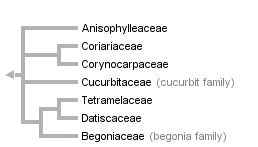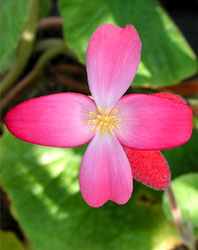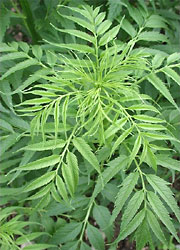Cucurbitales



This tree diagram shows the relationships between several groups of organisms.
The root of the current tree connects the organisms featured in this tree to their containing group and the rest of the Tree of Life. The basal branching point in the tree represents the ancestor of the other groups in the tree. This ancestor diversified over time into several descendent subgroups, which are represented as internal nodes and terminal taxa to the right.

You can click on the root to travel down the Tree of Life all the way to the root of all Life, and you can click on the names of descendent subgroups to travel up the Tree of Life all the way to individual species.
For more information on ToL tree formatting, please see Interpreting the Tree or Classification. To learn more about phylogenetic trees, please visit our Phylogenetic Biology pages.
close boxReferences
Bates, D.M., R. W. Robinson, and C. Jeffrey, eds. 1990. Biology and Utilization of the Cucurbitaceae. Comstock, Ithaca.
Carlquist, S. 1992. Wood anatomy of selected Cucurbitaceae and its relationship to habit and systematics. Nordic Journal of Botany 12:347-355.
Carlquist S. and R. B. Miller. 2001. Wood anatomy of Corynocarpaceae is consistent with cucurbitalean placement. Systematic Botany 26:54-65.
Kocyan, A., L.-B. Zhang, H. Schaefer, and S. S. Renner. 2007. A multi-locus chloroplast phylogeny for the Cucurbitaceae and its implications for character evolution and classification. Molecular Phylogenetics and Evolution 44(2):553-577.
Matthews, M. L. and P. K. Endress. 2004. Comparative floral structure and systematics in Cucurbitales (Corynocarpaceae, Coriariaceae, Tetramelaceae, Datiscaceae, Begoniaceae, Cucurbitaceae, Anisophylleaceae). Botanical Journal of the Linnean Society 145:129-185.
Matthews, M. L., P. K. Endress, J. Schönenberger, and E. M. Friis. 2001. A comparison of floral structures of Anisophylleaceae and Cunoniaceae and the problem of their systematic relationship. Annals of Botany 88:439-455.
Savolainen, V., M. W. Chase, S. B. Hoot, C. M. Morton, D. E. Soltis, C. Bayer, M. F. Fay, A. Y. De Bruijn, S. Sullivan, and Y. L. Qiu. 2000a. Phylogenetics of flowering plants based on combined analysis of plastid atpB and rbcL gene sequences. Systematic Biology 49:306-362.
Savolainen, V., M. F. Fay, D. C. Albach, A. Backlund, M. van der Bank, K. M. Cameron, S. A. Johnson, M. D. Lledó, J.-C. Pintaud, M. Powell, M. C. Sheahan, D. E. Soltis, P. S. Soltis, P. Weston, W. M. Whitten, K. J. Wurdack, and M. W. Chase. 2000b. Phylogeny of the eudicots: a nearly complete familial analysis based on rbcl gene sequences. Kew Bulletin 55:257-309.
Soltis, D. E., P. S. Soltis, M. W. Chase, M. E. Mort, D. C. Albach, M. Zanis, V. Savolainen, W. H. Hahn, S. B. Hoot, M. F. Fay, M. Axtell, S. M. Swensen, L. M. Prince, W. J. Kress, K. C. Nixon, and J. S. Farris. 2000. Angiosperm phylogeny inferred from 18S rDNA, rbcL, and atpB sequences. Botanical Journal of the Linnean Society 133:381-461.
Swensen, S. M., B. C. Mullin, and M. W. Chase. 1994. Phylogenetic affinities of Datiscaceae based on an analysis of nucleotide sequences from the plastid rbcL gene. Systematic Botany 19:157-168.
Zhang, L.-B., M. P. Simmons, A. Kocyan, and S. S. Renner. 2006. Phylogeny of the Cucurbitales based on DNA sequences of nine loci from three genomes: Implications for morphological and sexual system evolution. Molecular Phylogenetics and Evolution 39(2):305-322.
Title Illustrations

| Scientific Name | Begonia froebelii |
|---|---|
| Comments | Begoniaceae. Male flower of a plant cultivated at the Botanical Garden Basel, Switzerland. |
| Acknowledgements | courtesy Botanical Image Database |
| Sex | Male |
| Copyright |
© 2001 University of Basel, Basel, Switzerland

|
| Scientific Name | Cucumis sativus |
|---|---|
| Comments | Cucumber plant (Cucurbitaceae) |
| Copyright |
© Kurt Stüber

|
| Scientific Name | Datisca cannabina |
|---|---|
| Comments | Datiscaceae. Young plant cultivated at the Botanical Garden Basel, Switzerland |
| Acknowledgements | courtesy Botanical Image Database |
| Copyright |
© 2001 University of Basel, Basel, Switzerland

|
About This Page
Page copyright © 2009
All Rights Reserved.
Citing this page:
Tree of Life Web Project. 2002. Cucurbitales. Version 01 January 2002 (temporary). http://tolweb.org/Cucurbitales/21028/2002.01.01 in The Tree of Life Web Project, http://tolweb.org/











 Go to quick links
Go to quick search
Go to navigation for this section of the ToL site
Go to detailed links for the ToL site
Go to quick links
Go to quick search
Go to navigation for this section of the ToL site
Go to detailed links for the ToL site